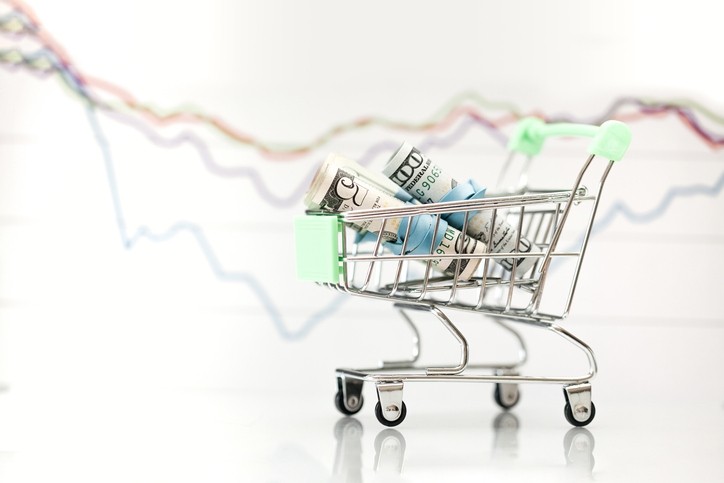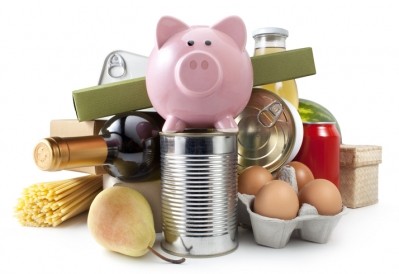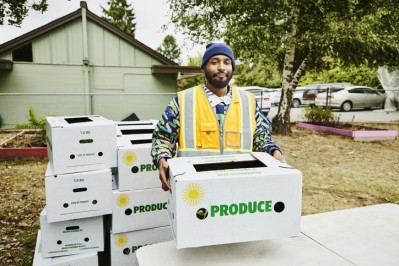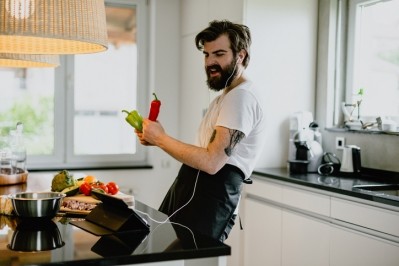IRI: “We could be anywhere near 7% to 10% price inflation as a benchmark” for CPGs late this year

“Mobility has been a primary determinant of food and beverage consumption at home, and as it grows, we have found that … food and beverage volume is coming down,” from a 40% spike in April 2020 compared to January-February 2020 to about 8% in April 2021 above pre-COVID-19, Krishnakumar Davey, president of strategic analytics at IRI, told attendees of a recent webinar hosted by the market research firm.
This drop mirrors a “return to normalcy” in terms of consumer mobility, which fell nearly 50% in April 2020 compared to January-February 2020 but by April 2021 was only about 30% below pre-COVID-19, IRI data shows.
This trend will continue through fiscal 2021, leveling out with consumption projected to be about 3% higher than pre-COVID levels by next January, which reflects an equal difference in mobility compared to before the outbreak as many consumers continue to work at home at least part time but offices and schools broadly reopen, Davey predicts.
Over this same period, CPG price inflation has slowly but steadily increased about 3.5% to 4% driven primarily by premiumization as consumers benefiting from stimulus funds traded up. This trend has been most prominent in the spice and seasoning category and sugar within edibles and dish detergent and cups & plates within non-edibles, according to IRI data.
A substantial reduction in promotions over the last 12 months, due to supply chain constraints, also contributed to the price mix shift, Davey noted, adding that consumers have accepted this dynamic during the pandemic, but may be less willing going forward.
Price increases are on the horizon
He explained many CPG manufactures have limited price increases so far thanks to hedging and newly developed cost efficiencies, but they will begin to implement them in earnest in the back half of the year.
Looking back, Davey said, price increases for edibles were up only 1.9% in 2019 over the previous year, but in 2020 this jumped to 3.3% and has continued to climb 4% in the first quarter of 2021 and 4.4% for the four weeks ending April 18. This trend holds true when viewed through a two year lens that “discounts for some of the unusual trends” in 2020, showing a percent change of 3.3% in 2019 over the prior two-year period and 6.7% in the four weeks ending April 18 compared to two years ago.
“Projected out, we could be anywhere near 7% to 10% price inflation as a benchmark” between the second half of this year and the fourth quarter, Davey predicted.
While consumers have been understanding of price increases, and in some cases voluntarily taking them with premiumization, Davey suggested price sensitivity is rising again as illustrated by the CPG average promoted price group price elasticity in the grocery channel, which shows a 17.1% reduction in volume from a 10% increase in price in the 39 weeks ending Feb. 28, 2021 compared to a 16.3% reduction in volume from the same price increase in the 26 weeks ending Oct. 26, 2020.
During the peak of the pandemic “price elasticity decreased quite a bit, but it’s picking back up. It’s not yet at the level of pre-pandemic, but we do see it’s coming back close to that,” Davey said, noting in the 39 weeks ending March 1, 2020 it reached 18.9% reduction in volume form a 10% increase in price of edible goods.
Further complicating this dynamic as the country comes out of lockdown is brands and retailers trying to maintain or regain market share – increasing competitive tensions, Davey said.
Managing revenue, inflation and price sensitivity
Against this background, Davey recommends brands pull different combinations of revenue management levers based on the specifics of their category and quickly shifting macro-economics.
Specifically, he recommends, companies should:
- Monitor price elasticity at a granular level with high frequency to capitalize on pricing opportunities in the supply-constrained environment. At PepsiCo, this means understanding the substitutes available to shoppers, said Evan Shaver, vice president of revenue growth management at PepsiCo Foods, North America. He explained during the webinar: “Sometimes it’s trading down, sometimes it is going to another category, sometimes it’s not buying at all. And, now more than ever, you have to really understand those and determine if it is worth taking action to keep that person with your product or would you rather let them leave for a while? You can do that for a little bit, but over the long term, that’s not a good way to build loyalty. So, understand those tradeoffs.”
- Continually track promotional effectiveness and invest in those with the highest returns. During the pandemic many companies pulled back on promotions to manage suppliers, but just because companies can offer those again doesn’t necessarily make it the best choice. Casey Geib, senior director of strategic revenue management at The Hershey Company said his team is asking, “Do we have to snap right back to the tried and true things?” He explained, “pre-pandemic, trade optimization was a big initiative for us,” but is that the best path forward now? And how is that weighed against “deep seated concerns about trying new things and the risks that come with that.”
- Understand price-pack opportunities across channels and consumers. Geib explained that developing new price-pack architectures is difficult now because of ongoing supply challenges and resource constraints, but in the long-run it better serves consumers because it gives them the flexibility to buy on value – whether they define that as buying more for less, or less at a higher price-per unit but a lower overall expense.
- Establish a ‘glide-path’ by increasing prices slowly and consistently over time. Geib explained this strategy helps cushion the impact of supply strains and eases planning by eliminating dramatic spikes every few years.
















